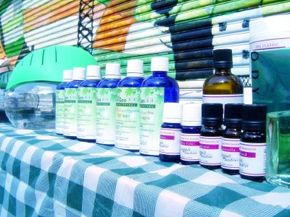How to Buy Essential Oils
At first, it may seem a formidable task to detect the difference between good and poor grades of oil or to spot a synthetic. But you'll be pleasantly surprised at how easy it becomes, after only a little practice, to sniff out good essential oils.
Until your nose knows, you'll have to trust your source. Each essential oil company decides the quality it will offer. Some companies consistently sell the poorer, cheaper grades while others prefer to sell the higher grades. They will rarely offer you, as a retail consumer, a choice in grades. As a result, some lines tend to be more expensive than others. But do not use price alone to judge an oil's quality, since lower grades of oil may be sold for far more than they are worth. Remember, too, that store clerks do not always know much about aromatherapy and may naively think that anything labeled an essential oil comes from the plant named.
Advertisement
Sophisticated advertising and fancy packaging may also be misleading. And, because not everyone cares about the healing effects, a few companies have filled the growing demand for scents with the cheapest means at their disposal. The most unscrupulous will sell low quality oils for the price of better ones.
This being said, you will find oils and related supplies at natural food stores, herb stores, specialty mail-order catalogs, and of course, at aromatherapy and skin care outlets. Some stores also have retail sites on the Internet.
Some essential oil mail-order companies are run by aromatherapists who stake their reputation on supplying high quality oils, so they may be the best way for you to get what you want. However, you need to know exactly what you want since you will not have the opportunity to sniff before purchase.
Price
There is great variation in the price of essential oils because some are more expensive to produce. In Bulgaria, schoolgirls labor in the misty morning, picking delicate rose petals just before the hot rays of the sun can release the fragrant oils into the air. Bulgaria produces the world's finest rose oil, but it takes about 600 pounds of petals to make a single ounce of oil! Rose oil also is expensive because the flowers must be carefully cultivated, pruned, and hand-picked.
Jasmine oil is expensive for similar reasons. Producing an ounce of pure jasmine requires 20 days labor for an experienced picker, followed by costly methods of extraction. As a result, rose and jasmine demand top dollar. On the other hand, peppermint is much less costly because the plant contains more essential oil, is relatively easy to grow and tend, and is harvested with machinery. The price of essential oils varies from $5 to an incredible $800 an ounce or more, reflecting the difficulty involved in their production.
Many other factors, such as difficult growing conditions, the rarity of the plant, or where the plant is grown, affect essential oil prices. Essential oils produced in the United States automatically demand a higher price to cover the greater costs of labor.
Surprisingly, cheaper oils will probably end up costing you more in the long run. Lesser quality oils are often weaker than high quality ones, and you will have to use more of them to achieve the same effect as a smaller amount of the high quality oil. Depending on how much more you have to use, you may end up spending more than if you'd simply purchased the better quality oil to begin with.
If you really want to make sure you get your money's worth from your essential oils, you'll want to learn how to store them properly. We'll cover this in the next section.
To learn more about Aromatherapy and other alternative medicines, see:
- Aromatherapy: Here you will learn about aromatherapy, how it works, what part essential oils play, and how to use aromatherapy.
- Essential Oils Profiles: We have collected profiles of dozens of plants that are used to produce essential oils. On these pages, you will learn the properties and preparations for the most popular essential oils.
- How to Treat Common Conditions With Aromatherapy: Aromatherapy can be used to treat a number of conditions, from asthma to depression to skin problems. Here you will learn how to treat some common medical problems with aromatherapy.
- Home Remedies: We have gathered over a hundred safe, time-tested home remedies for treating a wide variety of medical complaints yourself.
- Herbal Remedies: Herbal remedies and aromatherapy can be very similar, and they stem from similar historic roots. On this page, you will find all of our herb profiles and instructions for treating medical problems with herbal remedies.
This information is solely for informational purposes. IT IS NOT INTENDED TO PROVIDE MEDICAL ADVICE. Neither the Editors of Consumer Guide (R), Publications International, Ltd., the author nor publisher take responsibility for any possible consequences from any treatment, procedure, exercise, dietary modification, action or application of medication which results from reading or following the information contained in this information. The publication of this information does not constitute the practice of medicine, and this information does not replace the advice of your physician or other health care provider. Before undertaking any course of treatment, the reader must seek the advice of their physician or other health care provider.
